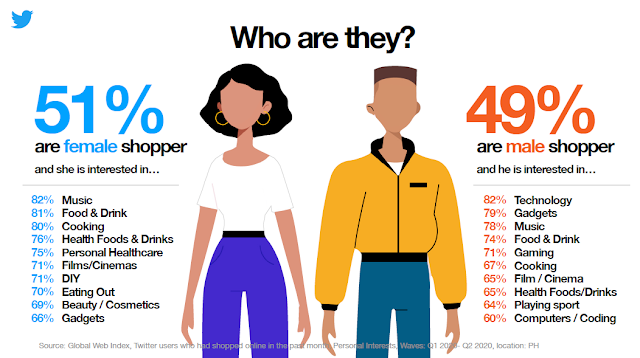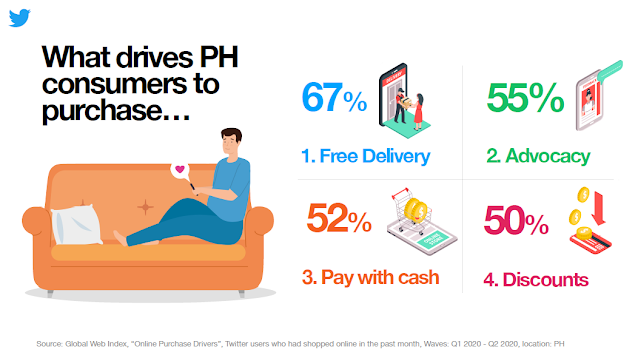As the pandemic accelerated the push for e-commerce, physical stores are now shifting its display racks online; bringing the rise of the upcoming 11.11 sale and other shopping days. Along with this is the evolution of how consumers behave and what they openly share regarding their shopping habits.
Twitter, as the go-to place for #WhatsHappening in the Philippines, is a hotspot for conversations around the latest buys, experiences, and online shopping sprees. These are accessible insights that can help brands understand consumers better and why adopting e-commerce is almost a non-negotiable for businesses.
“There’s no doubt that shopping conversations on Twitter are increasing across South East Asia. While we see peaks in the lead-up to eCommerce days and for a few days after, shopping is a year-round conversation on Twitter. As people are shifting more to eCommerce and mCommerce, we see this conversational trend continuing to grow rapidly,” said Arvinder Gujral - Managing Director, Twitter, South-East Asia.
“For brands, this requires a change in the way they approach their marketing. A more in-depth understanding of why people shop online and what influences their online shopping habits is needed, and in the Philippines we are seeing brands turn to Twitter to connect with their customers and leverage the leaned-in nature of people on Twitter in the Philippines.”
The way to a successful launch is to connect to moments and listen to know more of your audience, from their habits to their sentiments. Ace your e-commerce campaigns by understanding these 5 noteworthy changes on consumer behaviors on Twitter:
1. Most Filipinos bought their essentials online
The pandemic has impacted both companies and consumers. Since people #StayAtHome, Filipinos go over the internet to safely add to their shopping carts. In the past month, 78% of Filipinos on Twitter have recently purchased a product online while 93% have visited an online retail site or store to check out items.
Evolution of purchasing habits was also seen during the lockdown period, with Filipinos mostly stocking up on the essentials. Here are the top 5 items Filipino users bought online in the last month.
2. People think before they shop
As the famous saying goes, think before you click. When product photos and information wouldn’t suffice, online shoppers do their research to gather more details about the product and if it’s worth buying. Over 69% of Filipino online shoppers on Twitter always do their research first before making a purchase2, so brands must ensure that their content can actually guide consumers in making the right purchasing decisions.
The target audience is on Twitter, and they are highly receptive and engaging. 55% of Filipino online shoppers go to social media to discover what’s new in the market and check out real sentiments and reviews from buyers3. Jump in and go where people can see and connect with your brand.
3. Connecting to interests pique their attention
Everyone has their own shopping list and preference, so it’s important for brands to tailor-fit their approach and study what grabs the customer’s attention. Aside from creating campaigns that suit their target audience, knowing their interests gives an overview of what they will most likely search for, anticipate promos on, and eventually purchase.
When creating a message, brands can draw inspiration from the language of their target audience. For starters, Female shoppers are into music (82%), food and drink (81%), and cooking (80%), while top picks for male shoppers are technology (82%), gadgets (79%), and music (78%).4 Make your campaign relatable to those you want to tap.
4. Purchase drivers among Filipinos
Shopping in a store has its pros; all senses can be engaged such as tasting out a food sample or seeing the actual dimensions of an item, just to name a few. However, the situation right now calls for a safer shopping experience, which influences people to skip the queue and use their gadgets to buy online.
How can your campaign stand out from the rest of other sales? It lies in knowing which drives them to purchase. For Filipino online shoppers on Twitter, 67% are driven to purchase because of free delivery, 55% buy from brands who champion an advocacy, 52% check out if a store allows pay with cash, and 50% are enticed by discounts.5 Shoppers nowadays are more conscious about issues; so brands must definitely consider championing an advocacy genuinely.
5. Filipinos openly express excitement on shopping moments
Filipinos are known for being thrifty, so first-hand reviews and recommendations are highly appreciated. This is also the reason why people get excited about e-commerce shopping days and therefore, hypes up the moment. This buzz is created by the audience themselves that brands to leverage from to drive engagements and potential sales.
Though 9/9, 10/10, or 11/11 sales only happen for one day, conversations around it actually begin and last longer. For brands to successfully launch their campaigns, here’s an overview on how conversations unfold during e-commerce shopping days, and how brands can successfully tread the whole journey.
1. Start of conversation (5-7 days before E-commerce Shopping Day) - Start publishing your online content.
2. Warm up (2-3 days before actual day) - Don’t waste the momentum! Tease and hype it up some more.
3. E-Commerce Day - a huge spike in conversation; go all out and create a conversation.
4. Unboxing (2-3 days after) - Parcels are delivered; be ready to see (and re-share) reviews online!
5. Aftermath (5-7 days after) - Convos have mellowed down; but online content must continue.
Brands and consumers alike interact on Twitter, opening a good chance to build brand loyalty and gather valuable insights for growth and better customer experience. If E-commerce is happening, then Twitter is definitely #WhatsHappening.






Post a Comment